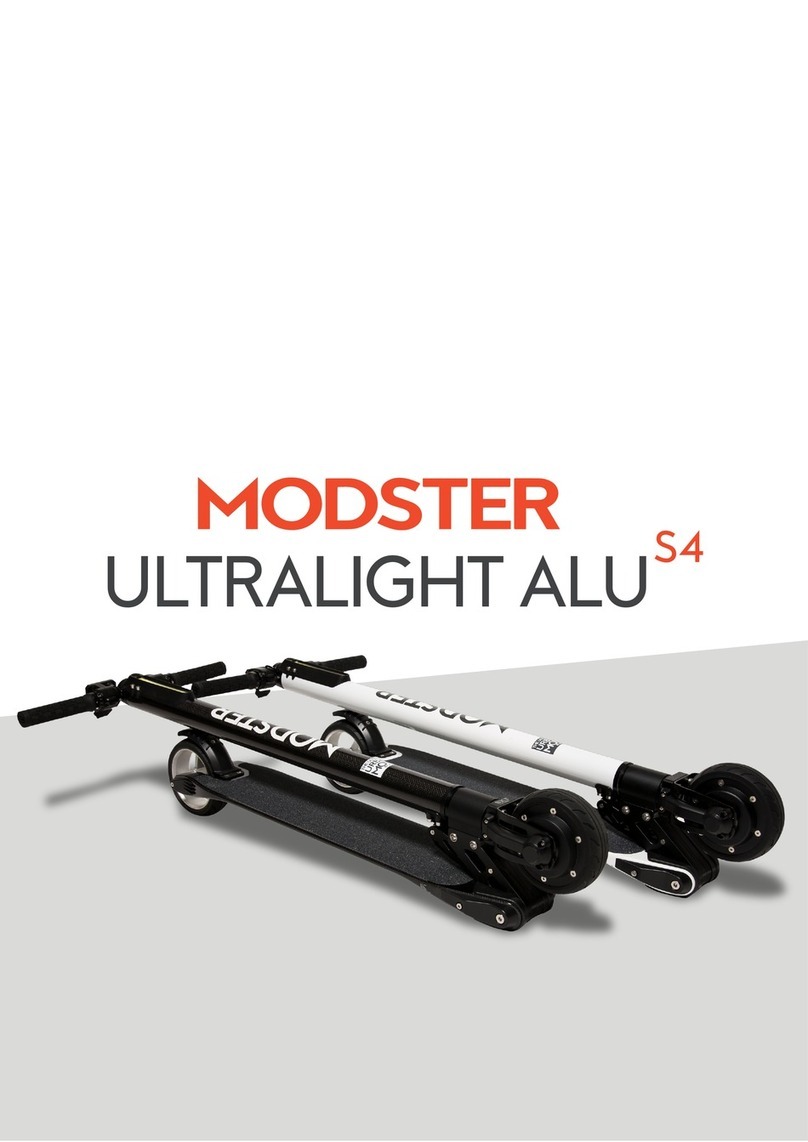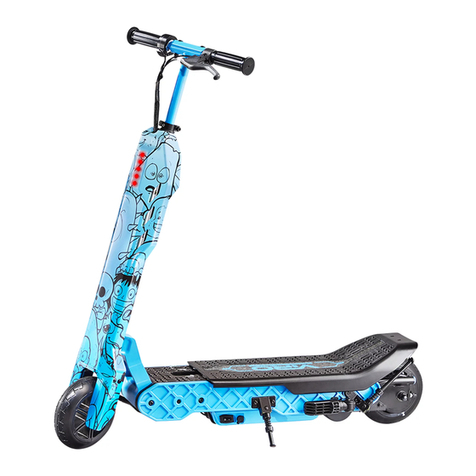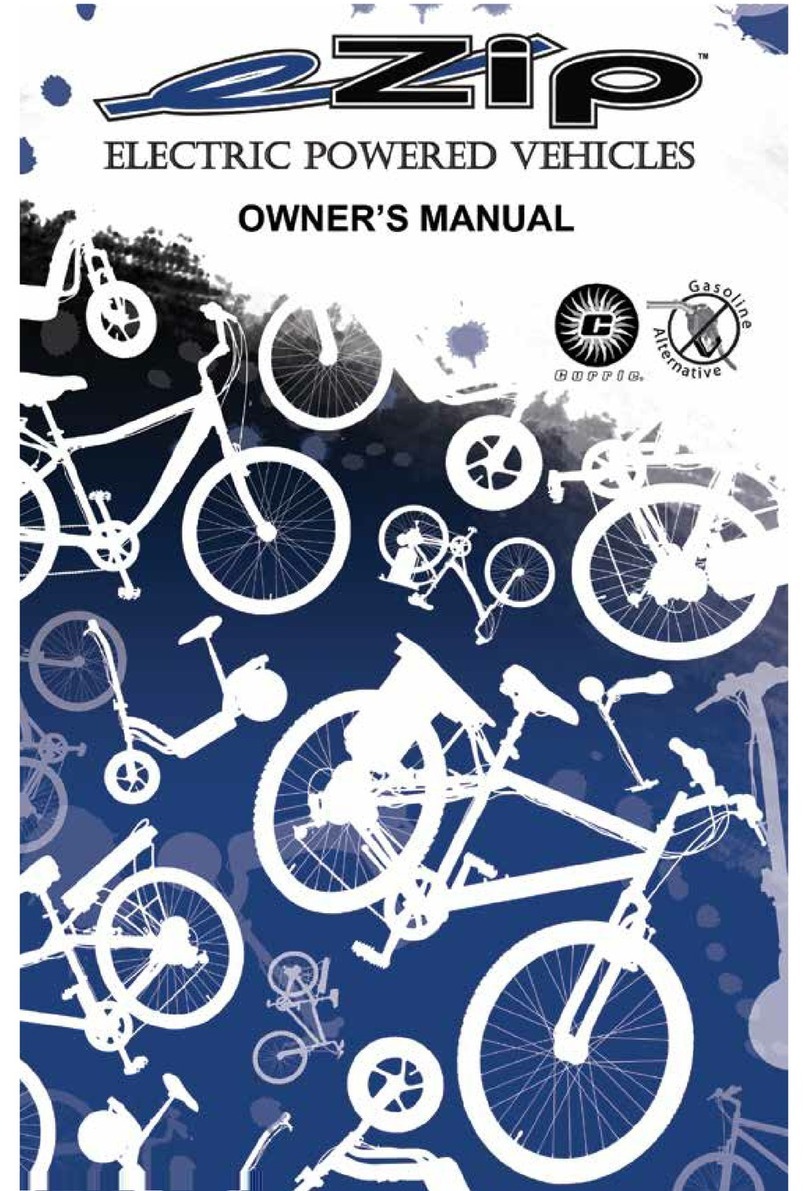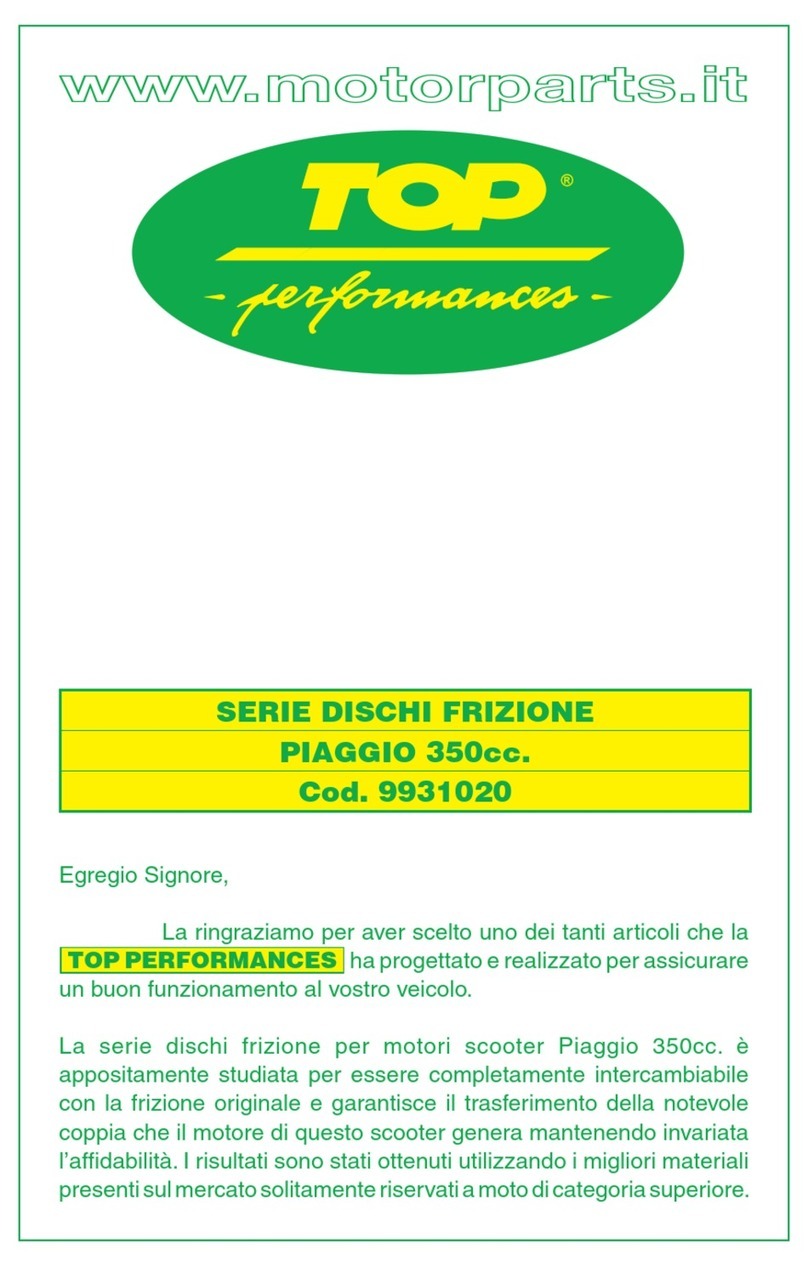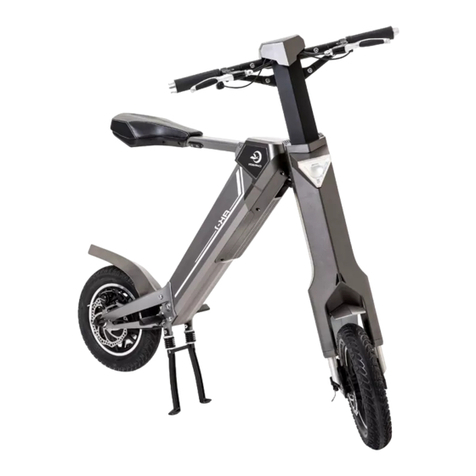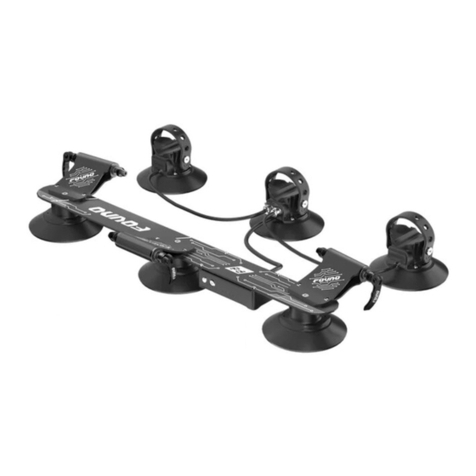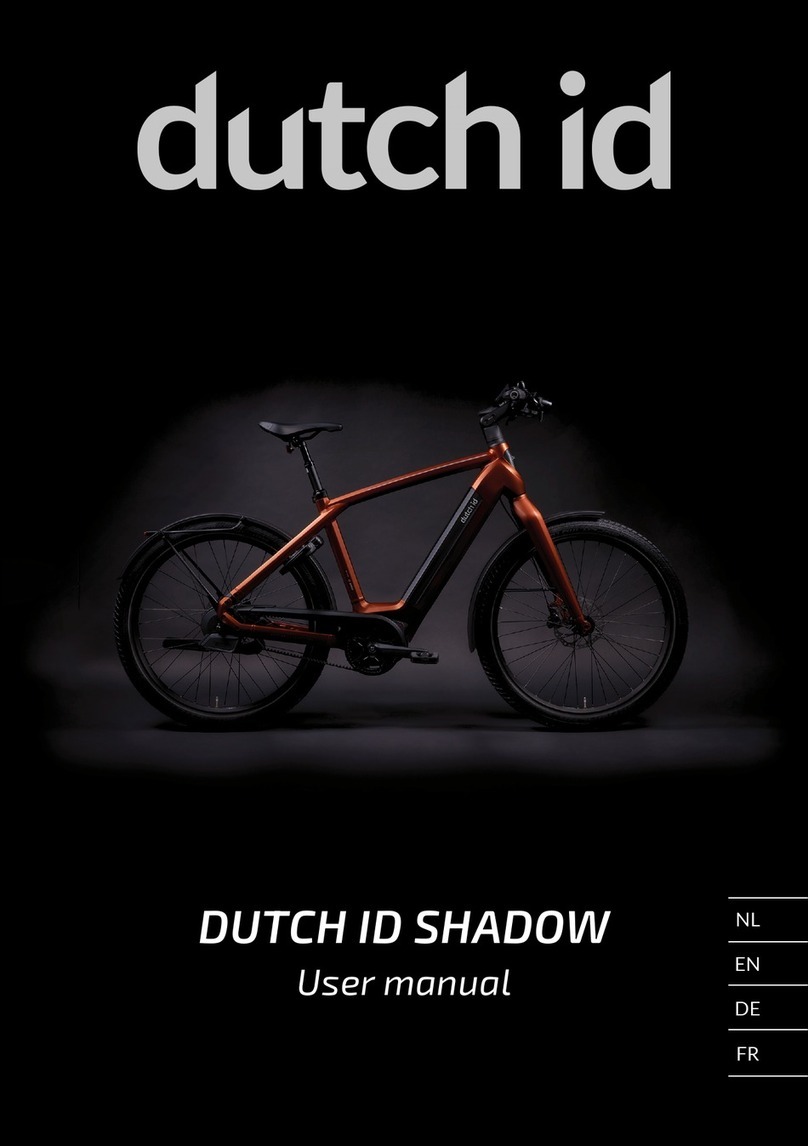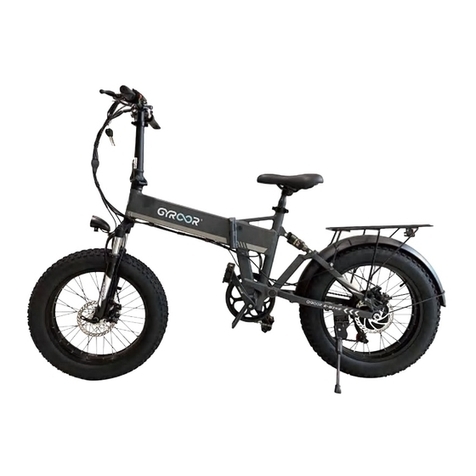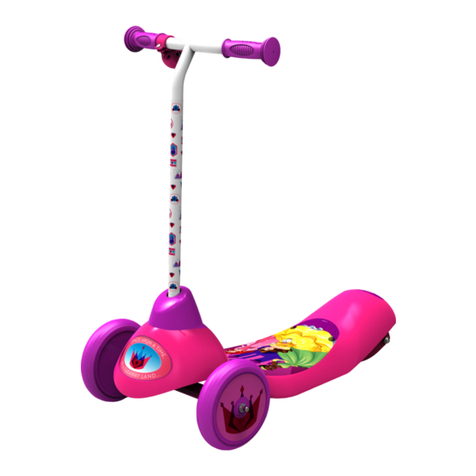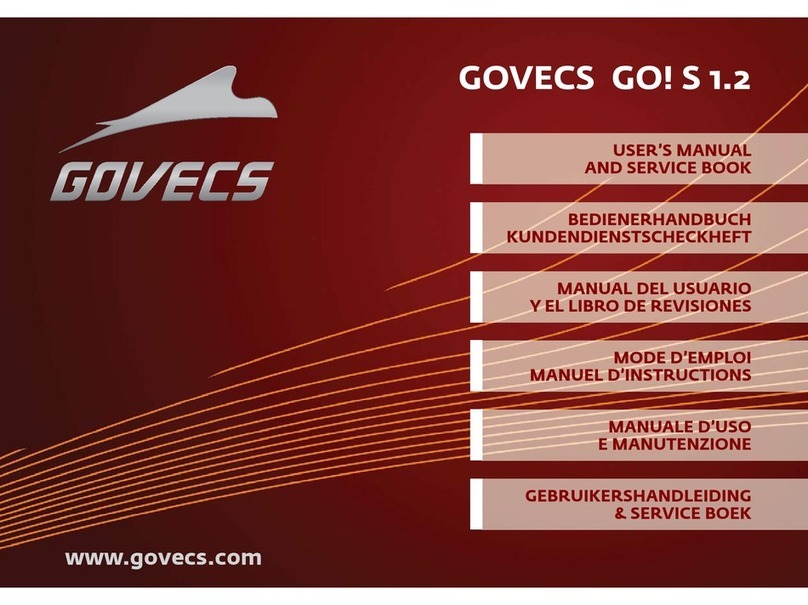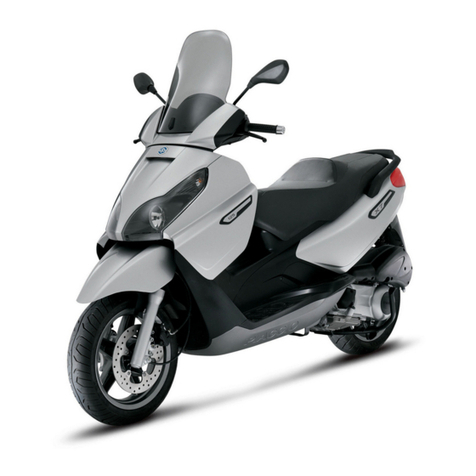freebeat MORPH User manual

OWNER’S
MANUAL
MORPH 2-IN-1 EBIKE

IMPORTANT
This manual contains essential safety, performance, and service
information. Please read it carefully before taking your first ride on
your new bicycle, and keep it for future reference.
Additional safety, performance, and service information specific to
components such as suspension or pedals on your bicycle, as well as
accessories like helmets or lights, may also be available. Ensure that
your dealer has provided you with all the manufacturer's information
included with your bicycle or accessories. In case of any conflict
between the instructions in this manual and the information
provided by a component manufacturer, always follow the
component manufacturer's instructions.
If you have any questions or do not understand something, take
responsibility for your safety and consult with your dealer or the
bicycle manufacturer.
Please note that this manual is not intended to be a comprehensive
guide for use, service, repair, or maintenance. For service, repairs, or
maintenance, please contact your dealer. They may also be able to
refer you to classes, clinics, or books on bicycle use, service, repair, or
maintenance.
INTRODUCTION
Congratulations! Thank you for purchasing a freebeat bike! You now
have the ultimate urban bike in your hands.
Instead of going through the entire manual, we understand that
you're probably eager to start riding. We have condensed the
content to only include the most important information so that you
can hit the road and embrace your city as soon as possible.
Website: www.freebeatfit.com
Email: customerservice@freebeatfit.com
Cal:+1 833-534-8418
Hours: 1 PM - 7 PM ET, 7 DAYS A WEEK
BICYCLE OWNER'S MANUAL
A. GENERALWARNING
B. SPECIAL NOTE FOR PARENTS
1. FIRST
A. SAFETY FIRST
B. MECHANICALSAFETY CHECK
2. SAFETY
A. THE BASICS
B. RIDING SAFETY
C. OFF ROAD SAFETY
D. WETWEATHER RIDING
E. NIGHT RIDING
F. EXTREME, STUNT, OR COMPETITION RIDING
G. CHANGING COMPONENTS OR ADDING ACCESSORIES
3. FIT
A. STANDOVER HEIGHT
B. SADDLE POSITION
C. HANDLEBAR HEIGHT AND ANGLE
D. CONTROL POSITION ADJUSTMENTS
E. BRAKE REACH
4. MECHANICAL & ELECTRICAL PARTS
A. WHEELS
B. SEAT POST CLAMP
C. BRAKES
D. SHIFTING GEARS
E. PEDALS
F. SUSPENSION
G. TIRES AND TUBES
H. ELECTRICAL SYSTEM
I. INDOOR/OUTDOOR MODE SWITCH
5. UNBOXING ASSEMBLY INSTRUCTIONS
A. UNBOXING ………………………………………………………………………………………………………………………………
B. FRONT WHEEL ASSEMBLY ……………………………………………………………………………………………
C. DISC BRAKE CALIBRATION …………………………………………………………………………………………
D. HANDLEBAR ASSEMBLY ………………………………………………………………………………………………
E. SEAT ADJUSTMENT ……………………………………………………………………………………………………………
F. PEDAL ASSEMBLY ………………………………………………………………………………………………………………
G. FRONT LIGHT ASSEMBLY ………………………………………………………………………………………………
H. BATTERY INSTALLATION ………………………………………………………………………………………………
I. BATTERY CHARGING ………………………………………………………………………………………………………
J. INDOOR WORKING STATION ……………………………………………………………………………………
K. START YOUR BIKE ………………………………………………………………………………………………………………
6. OPERATION INSTRUCTION
A. BRAKE OPERATION …………………………………………………………………………………………………………
B. GEAR OPERATION ……………………………………………………………………………………………………………
C. POWER ON/OFF OPERATION ……………………………………………………………………………………
D. PEDAL ASSIST CONTROL(PAS) OPERATION ……………………………………………………
E. THROTTLE OPERATION …………………………………………………………………………………………………
F. FRONT LIGHT OPERATION ……………………………………………………………………………………………
G. BATTERY CHAROINO OPERATION …………………………………………………………………………
7. MOVING & STORAGE INSTRUCTION
A. LONG-TERM BATTERY STORAGE …………………………………………………………………………………
8. USER MAINTENANCE INSTRUCTIONS
A. SERVICE …………………………………………………………………………………………………………………………………………
B. BICYCLE CARE ……………………………………………………………………………………………………………………………
C. APPENDIX A …………………………………………………………………………………………………………………………………
D. APPENDIX B …………………………………………………………………………………………………………………………………
To access the online user manual, view the
instructions for using the freebeat app, please scan
the QR code provided below.

TABLE
OF CONTENT
A. GENERALWARNING ………………………………………………………………………………………………………………
B. SPECIAL NOTE FOR PARENTS …………………………………………………………………………………………
1. FIRST
A. SAFETY FIRST …………………………………………………………………………………………………………………………
B. MECHANICALSAFETY CHECK ……………………………………………………………………………………
2. SAFETY
A. THE BASICS ……………………………………………………………………………………………………………………………
B. RIDING SAFETY ……………………………………………………………………………………………………………………
C. OFF ROAD SAFETY ……………………………………………………………………………………………………………
D. WETWEATHER RIDING
……………………………………………………………………………………………………
E. NIGHT RIDING ………………………………………………………………………………………………………………………
F. EXTREME, STUNT, OR COMPETITION RIDING …………………………………………………
G. CHANGING COMPONENTS OR ADDING ACCESSORIES …………………………
3. FIT
A. STANDOVER HEIGHT ………………………………………………………………………………………………………
B. SADDLE POSITION ……………………………………………………………………………………………………………
C. HANDLEBAR HEIGHT AND ANGLE
…………………………………………………………………………
D. CONTROL POSITION ADJUSTMENTS ……………………………………………………………………
E. BRAKE REACH ………………………………………………………………………………………………………………………
4. MECHANICAL & ELECTRICAL PARTS
A. WHEELS ……………………………………………………………………………………………………………………………………
B. SEAT POST CLAMP ……………………………………………………………………………………………………………
C. BRAKES ……………………………………………………………………………………………………………………………………
D. SHIFTING GEARS …………………………………………………………………………………………………………………
E. PEDALS ………………………………………………………………………………………………………………………………………
F. SUSPENSION …………………………………………………………………………………………………………………………
G. TIRES AND TUBES ………………………………………………………………………………………………………………
H. ELECTRICAL SYSTEM ………………………………………………………………………………………………………
I. INDOOR/OUTDOOR MODE SWITCH ……………………………………………………………………
01
02
03
04
07
08
10
11
11
13
15
16
17
20
21
21
22
29
30
32
32
34
35
37
43
A. GENERALWARNING
B. SPECIAL NOTE FOR PARENTS
1. FIRST
A. SAFETY FIRST
B. MECHANICALSAFETY CHECK
2. SAFETY
A. THE BASICS
B. RIDING SAFETY
C. OFF ROAD SAFETY
D. WETWEATHER RIDING
E. NIGHT RIDING
F. EXTREME, STUNT, OR COMPETITION RIDING
G. CHANGING COMPONENTS OR ADDING ACCESSORIES
3. FIT
A. STANDOVER HEIGHT
B. SADDLE POSITION
C. HANDLEBAR HEIGHT AND ANGLE
D. CONTROL POSITION ADJUSTMENTS
E. BRAKE REACH
4. MECHANICAL & ELECTRICAL PARTS
A. WHEELS
B. SEAT POST CLAMP
C. BRAKES
D. SHIFTING GEARS
E. PEDALS
F. SUSPENSION
G. TIRES AND TUBES
H. ELECTRICAL SYSTEM
I. INDOOR/OUTDOOR MODE SWITCH
5. UNBOXING ASSEMBLY INSTRUCTIONS
A. UNBOXING ………………………………………………………………………………………………………………………………
B. FRONT WHEEL ASSEMBLY ……………………………………………………………………………………………
C. DISC BRAKE CALIBRATION …………………………………………………………………………………………
D. HANDLEBAR ASSEMBLY ………………………………………………………………………………………………
E. SEAT ADJUSTMENT ……………………………………………………………………………………………………………
F. PEDAL ASSEMBLY ………………………………………………………………………………………………………………
G. FRONT LIGHT ASSEMBLY ………………………………………………………………………………………………
H. BATTERY INSTALLATION ………………………………………………………………………………………………
I. BATTERY CHARGING ………………………………………………………………………………………………………
J. INDOOR WORKING STATION ……………………………………………………………………………………
K. START YOUR BIKE ………………………………………………………………………………………………………………
6.
OPERATION INSTRUCTION
A. BRAKE OPERATION …………………………………………………………………………………………………………
B. GEAR OPERATION ……………………………………………………………………………………………………………
C. POWER ON/OFF OPERATION ……………………………………………………………………………………
D. PEDAL ASSIST CONTROL(PAS) OPERATION ……………………………………………………
E. THROTTLE OPERATION …………………………………………………………………………………………………
F. FRONT LIGHT OPERATION ……………………………………………………………………………………………
G. BATTERY CHAROINO OPERATION …………………………………………………………………………
7.
MOVING & STORAGE INSTRUCTION
A.
LONG-TERM BATTERY STORAGE …………………………………………………………………………………
8.
USER MAINTENANCE INSTRUCTIONS
A.
SERVICE …………………………………………………………………………………………………………………………………………
B.
BICYCLE CARE ……………………………………………………………………………………………………………………………
C.
APPENDIX A …………………………………………………………………………………………………………………………………
D.
APPENDIX B …………………………………………………………………………………………………………………………………
45
45
45
46
46
46
47
47
47
48
48
49
49
49
50
51
51
51
54
56
56
57
58

Like any sport, bicycling involves the risk of injury and damage. By
choosing to ride a bicycle, you accept the responsibility for that risk.
It is important to be aware of and follow the rules of safe and
responsible riding, as well as proper use and maintenance of your
bicycle. Proper use and maintenance will reduce the risk of injury.
This Manual contains various "Warnings" and "Cautions" regarding
the consequences of failing to maintain or inspect your bicycle, as
well as failing to follow safe cycling practices.
The combination of the safety alert symbol and the word
"WARNING" indicates a potentially hazardous situation that, if not
avoided, could result in serious injury or death.
The combination of the safety alert symbol and the word
"CAUTION" indicates a potentially hazardous situation that, if not
avoided, may result in minor or moderate injury, or serves as an alert
against unsafe practices.
The word "CAUTION" used without the safety alert symbol indicates
a situation that, if not avoided, could result in serious damage to the
bicycle or the voiding of your warranty.
Many of the warnings and cautions mention the possibility of losing
control and falling, as any fall can result in serious injury or even
death. We do not always repeat the warning of possible injury or
death. Since it is impossible to anticipate every situation or
condition that may occur while riding, this manual does not
guarantee the safe use of the bicycle under all conditions. There are
risks associated with the use of any bicycle that cannot be
predicted or avoided, and it is solely the responsibility of the rider to
manage these risks.
As a parent or guardian, it is your responsibility to ensure the activities
and safety of your minor child. This includes making sure that their
bicycle is properly fitted, in good repair, and safe to operate. It is
important that both you and your child learn and understand how to
safely operate the bicycle, as well as obey local motor vehicle, bicycle, and
traffic laws. Additionally, it is crucial to follow common sense rules for safe
and responsible cycling. Before allowing your child to ride the bicycle, you
should read this manual and review its warnings, as well as the bicycle's
functions and operating procedures with your child.
Always ensure that your child wears an approved bicycle
helmet when riding. However, it is also important to make sure
your child understands that a helmet is only for bicycling and
should be removed when not riding. A helmet should not be
worn while playing in play areas, on playground equipment, or
while climbing trees. Failure to follow this warning could result
in serious injury or death.
Make sure that your child's bicycle is correctly sized so that
when the saddle is adjusted properly, both feet can touch the
ground. If your child's new bike does not fit, ask your dealer to
exchange it before riding.
GENERALWARNING A SPECIAL NOTE FOR PARENTS
WARNING
A. GENERALWARNING
B. SPECIAL NOTE FOR PARENTS
1. FIRST
A. SAFETY FIRST
B. MECHANICALSAFETY CHECK
2. SAFETY
A. THE BASICS
B. RIDING SAFETY
C. OFF ROAD SAFETY
D. WETWEATHER RIDING
E. NIGHT RIDING
F. EXTREME, STUNT, OR COMPETITION RIDING
G. CHANGING COMPONENTS OR ADDING ACCESSORIES
3. FIT
A. STANDOVER HEIGHT
B. SADDLE POSITION
C. HANDLEBAR HEIGHT AND ANGLE
D. CONTROL POSITION ADJUSTMENTS
E. BRAKE REACH
4. MECHANICAL & ELECTRICAL PARTS
A. WHEELS
B. SEAT POST CLAMP
C. BRAKES
D. SHIFTING GEARS
E. PEDALS
F. SUSPENSION
G. TIRES AND TUBES
H. ELECTRICAL SYSTEM
I. INDOOR/OUTDOOR MODE SWITCH
5. UNBOXING ASSEMBLY INSTRUCTIONS
A. UNBOXING ………………………………………………………………………………………………………………………………
B. FRONT WHEEL ASSEMBLY ……………………………………………………………………………………………
C. DISC BRAKE CALIBRATION …………………………………………………………………………………………
D. HANDLEBAR ASSEMBLY ………………………………………………………………………………………………
E. SEAT ADJUSTMENT ……………………………………………………………………………………………………………
F. PEDAL ASSEMBLY ………………………………………………………………………………………………………………
G. FRONT LIGHT ASSEMBLY ………………………………………………………………………………………………
H. BATTERY INSTALLATION ………………………………………………………………………………………………
I. BATTERY CHARGING ………………………………………………………………………………………………………
J. INDOOR WORKING STATION ……………………………………………………………………………………
K. START YOUR BIKE ………………………………………………………………………………………………………………
6. OPERATION INSTRUCTION
A. BRAKE OPERATION …………………………………………………………………………………………………………
B. GEAR OPERATION ……………………………………………………………………………………………………………
C. POWER ON/OFF OPERATION ……………………………………………………………………………………
D. PEDAL ASSIST CONTROL(PAS) OPERATION ……………………………………………………
E. THROTTLE OPERATION …………………………………………………………………………………………………
F. FRONT LIGHT OPERATION ……………………………………………………………………………………………
G. BATTERY CHAROINO OPERATION …………………………………………………………………………
7. MOVING & STORAGE INSTRUCTION
A. LONG-TERM BATTERY STORAGE …………………………………………………………………………………
8. USER MAINTENANCE INSTRUCTIONS
A. SERVICE …………………………………………………………………………………………………………………………………………
B. BICYCLE CARE ……………………………………………………………………………………………………………………………
C. APPENDIX A …………………………………………………………………………………………………………………………………
D. APPENDIX B …………………………………………………………………………………………………………………………………
01 02

Before every ride, it is important to routinely check the condition of your bicycle.
NUTS, BOLTS SCREWS, AND OTHER FASTENERS:
Manufacturers utilize a wide range of fastener sizes, shapes, and materials,
making it crucial to apply the correct tightening force or torque.
Unfortunately, there is no one-size-fits-all approach to tightening these
fasteners. To ensure proper tightening, it is imperative to refer to the torque
specifications provided by the specific bicycle or component manufacturer.
It is highly recommended to use a calibrated torque wrench to achieve
accurate torque values. If you choose to undertake maintenance on your
own, be sure to use a torque wrench and follow the tightening torque
specifications meticulously. However, for peace of mind and to guarantee
utmost safety, it is strongly advised to have a professional bicycle mechanic
inspect the fasteners you have worked on as soon as possible.
•Make sure nothing is loose before your ride, lift the front wheel a few
inches off the ground and let it bounce. Pay close attention to any
unusual sounds, sensations, or visual indications of looseness. Conduct a
meticulous inspection of the entire bicycle, checking for any loose parts or
accessories. If you are uncertain about any aspect of the inspection, it is
highly recommended to seek assistance from an experienced individual
with knowledge of bike maintenance. Your safety should always be the
top priority.
FIRST
We highly recommend that you read this manual in its
entirety before your first ride. At the very least, ensure that you
understand each point mentioned in this section. If you have
any questions or concerns, refer to the specified sections for
further clarification. Please note that not all bicycles may have
all the features described in this manual. You can ask your
dealer to show you the specific features of your bicycle.
NOTE
Applying the correct tightening force to fasteners, such as nuts,
bolts, and screws, is of the utmost importance. Inadequate
force may result in loose fasteners, compromising the integrity
of the bicycle. Conversely, excessive force can lead to thread
damage, stretching, deformation, or breakage. Either scenario
can result in component failure, potentially causing loss of
control and accidents.
WARNING
•Always wear an approved helmet when riding your bike, and make
sure to follow the instructions provided by the helmet manufacturer for
proper fitting, usage, and care.
•Do you have all the necessary safety equipment required and
recommended for riding your bike? It is your responsibility to familiarize
yourself with the laws and regulations of the areas where you ride and
ensure that you comply with all applicable laws.
•Do you know how to properly secure your front and rear wheels? Riding
with improperly secured wheels can cause the wheel to wobble or
disengage from the bicycle, resulting in serious injury or even death.
•Does your bike have suspension? Suspension can greatly affect the
performance of a bicycle. It is crucial to follow the instructions provided
by the suspension manufacturer for proper adjustment and
maintenance.
A. SAFETY FIRST
B. MECHANICALSAFETY CHECK
03 04

TIRES AND WHEELS:
Ensure that the tires are properly inflated (refer to the Quick Start
Guide for instructions). To check the tire pressure, place one hand on
the saddle and the other on the intersection of the handlebars and
stem. Bounce your weight on the bike while observing the tire
deflection. Compare the deflection with how it should look when the
tires are correctly inflated and adjust as necessary.
Are the tires in good condition? Spin each wheel slowly and inspect
the tread and sidewall for any cuts or damage. It is important to
replace damaged tires before riding the bike.
Are the wheels true? Spin each wheel and check for brake clearance
and any side-to-side wobble. If a wheel wobbles slightly, rubs against,
or hits the brake pads, it is recommended to take the bike to a
qualified bike shop for wheel truing. Truing wheels require special
tools and experience, so it is not advisable to attempt it unless you
have the necessary knowledge, experience, and tools.
Bicycle wheel rims are subject to wear. Some rims have a rim
wear indicator that becomes visible as the braking surface
wears down. If a rim wear indicator is visible on the side of the
wheel rim, it indicates that the rim has reached its maximum
usable life. Riding a wheel that is at the end of its usable life
can result in wheel failure, leading to loss of control and
potential accidents.
NOTE
Ensure that the wheel rims are clean and undamaged. Check
the cleanliness and inspect for any damage at the tire bead. If
you have rim brakes, also inspect the braking surface. Ensure
that no rim wear indicator markings are visible at any point on
the wheel rim.
WARNING
BRAKES:
Check the brakes for proper operation. Squeeze the brake levers and
ensure that the brake quick-release mechanisms are engaged. Verify
that all control cables are seated and securely engaged. If you have
rim brakes, confirm that the brake pads make solid contact with the
wheel rims and fully engage within an inch of brake lever movement.
You should be able to apply full braking force without the levers
touching the handlebar. If adjustments are needed, do not ride the
bike until the brakes are properly adjusted by a professional bicycle
mechanic.
•Ensure that the front and rear wheels are securely fastened in the
wheel retention system.
•If your seat post has an over-center cam action fastener for easy
height adjustment, check that it is properly adjusted and locked in
position.
•Confirm that the saddle and handlebar stem are parallel to the
bike's center line and tightened sufficiently to prevent twisting or
misalignment.
•Check that the handlebar grips are securely attached and in good
condition. Ensure that the handlebar ends and extensions are
properly plugged. If you have bar end extensions, make sure they
are tightly clamped to prevent any twisting.
It is crucial to replace any handlebar grips, end plugs, or
extensions that are loose or damaged. These components can
expose the ends of the handlebars, posing a risk of injury and
potentially leading to loss of control and falls. Additionally,
handlebars or extensions that are not properly plugged can
cause cuts and serious injuries, even in minor accidents.
Therefore, it is important to ensure that all handlebar
components are securely in place to maintain rider safety.
WARNING
05 06

SAFETY
Avoid jumping on your bike. While jumping can be thrilling, it places
significant and unpredictable stress on both the bicycle and its
components. Riders who insist on jumping their bikes not only risk
serious damage to their bicycles but also put themselves in harm's way.
Always ride at a speed that is appropriate for the present conditions.
Remember that higher speeds increase the risk of accidents and
potential injuries. It is crucial to prioritize safety over speed.
The area where you ride may have specific safety
requirements. It is your responsibility to familiarize yourself
with the local laws and regulations and comply with them.
This includes ensuring that you and your bike are properly
equipped as per the law.
WARNING
Protective eyewear is essential to shield your eyes from airborne dirt,
dust, and bugs. Choose tinted lenses for bright sunny conditions and
clear lenses for other times when visibility is not an issue.
A. THE BASICS
B. RIDING SAFETY
7.
8.
Here are some guidelines to follow:
1. Always wear a helmet that meets the latest certification standards
and is suitable for the type of riding you do. Follow the
manufacturer's instructions for fitting, using, and maintaining your
helmet. Head injuries are often severe in bicycle accidents and can
be prevented by wearing a proper helmet.
2. Before riding a bike, always perform a thorough bike check to
make sure everything is in proper working order.
3. Be fully acquainted with the controls of your bicycle, including the
brakes, pedals, and shifting mechanisms.
4. Take caution to keep body parts and other objects away from the
sharp teeth of the chainrings, the moving chain, the rotating
pedals and cranks, and the spinning wheels of your bike.
5. Wear appropriate shoes that securely stay on your feet and provide
grip on the pedals. Ensure that shoelaces cannot get tangled in
moving parts, and never ride barefoot or in sandals.
6. Wear bright, visible clothing that is not too loose, as loose clothing
can become entangled in your bike or snagged by objects along
the road or trail.
1. Adhere to all rules of the road and comply with local traffic laws.
2. Remember that you are sharing the road or path with other motorists,
pedestrians, and cyclists. Respect their rights and prioritize safety.
3. Ride defensively and assume that others may not see you. Always be
prepared to react to potential hazards.
4. Stay alert and be ready to avoid various obstacles such as slowing or
turning vehicles, opening car doors, pedestrians stepping out, potholes,
grates, railroad tracks, construction, debris, and other potential obstructions.
5. Ride in designated bike lanes or paths, or as close to the edge of the
road as possible, in the direction of traffic flow according to local laws.
6. Stop at stop signs and traffic lights, and look both ways at street
intersections. Yield if necessary, even if you have the right of way.
7. Use approved hand signals for turning and stopping.
8. Avoid riding with headphones as they can mask important traffic
sounds and emergency vehicle sirens, distracting you from your
surroundings and posing a risk of entanglement in moving bicycle parts.
9. Do not carry a passenger unless it is a small child wearing an approved
helmet and secured in a correctly mounted child carrier or trailer.
Ensure that the bicycle is suitable for carrying passengers and does not
exceed the maximum weight limit.
07 08

We recommend that children do not ride on rough terrain or in the
rain unless accompanied by an adult.
1. Off-road biking requires careful attention and specific skills due to
variable conditions and hazards. Start slowly on easier terrain to
develop skills and gradually progress to higher speeds or more
challenging terrain. If your bike has suspension, be aware that
increased speed also increases the risk of losing control and falling.
Familiarize yourself with safe bike handling before attempting more
difficult situations.
2. Always wear appropriate safety gear for the type of riding you plan
to do.
3. Avoid riding alone in remote areas. Even when riding with others,
ensure that someone knows your intended route and expected
return time.
4. Carry identification in case of an accident and bring money, food, a
drink, and a mobile phone for emergencies.
5. Yield the right of way to pedestrians and animals. Ride in a manner
that doesn't frighten or endanger them and give them enough
space to make unexpected moves without putting your safety at
risk.
6. Be prepared in case something goes wrong while riding off-road, as
help may not be readily available.
7. Respect off-road regulations and obey local laws. Be mindful of
private property and remember that you may be sharing the trail
with hikers, equestrians, and other cyclists. Stay on designated trails
and avoid contributing to erosion by riding in mud or unnecessarily
sliding.
8. Preserve the ecosystem by avoiding cutting your own trail or taking
shortcuts through vegetation or streams. Minimize your impact on
the environment and leave everything as you found it. Remove any
waste or belongings you brought in with you.
The minimum age for riding should be 16 years or older, with
proper protective gear.
10.
It is recommended to transport children using a towed trailer
instead of a child carrier mounted to the frame. Keep in mind
that towing a trailer affects stopping distances, turning radius,
and bicycle handling.
Children should always wear a helmet while in a child carrier or
trailer. Refer to local laws regarding bicycle helmet usage.
Do not carry anything that obstructs your vision or control of the
bicycle, or that can become entangled in moving parts.
Never hitch a ride by holding onto another vehicle.
Avoid performing stunts, wheelies, or jumps unless you have the
necessary skills and are willing to accept the risks involved.
Do not weave through traffic or make sudden moves that may
surprise others on the road.
Observe and yield the right of way when necessary.
Never ride a bicycle under the influence of alcohol or drugs.
If possible, avoid riding in bad weather, during low visibility
conditions at dawn, dusk, or in the dark, or when excessively
tired. These conditions increase the risk of accidents.
11.
12.
13.
14.
15.
16.
17.
18.
19.
Child carriers and racks can affect the handling of a
bicycle, altering the weight distribution and balance.
Use them cautiously to prevent loss of control and
serious injury or death.
WARNING
C. OFF ROAD SAFETY
09 10

D. WETWEATHER RIDING
E. NIGHT RIDING
In wet conditions, the effectiveness of your brakes, as well as the brakes
of other vehicles on the road, is significantly reduced, and your tires have
less grip. This makes it more difficult to control your speed and increases
the risk of losing control. To ensure that you can slow down and stop
safely in wet conditions, ride at a slower pace and apply your brakes
earlier and more gradually than you would in normal, dry conditions.
Riding a bicycle at night is much more dangerous than riding during
the day. A bicyclist is very difficult for motorists and pedestrians to see.
Therefore, children should never ride at dawn, at dusk, or at night. Adults
who choose to accept the greatly increased risk of riding at dawn, at
dusk, or at night need to take extra care both riding and choosing
proper equipment which helps reduce that risk.
Bicycle reflectors are specifically designed to reflect car lights and street
lights, increasing your visibility and helping others recognize you as a
moving cyclist.
Furthermore, the mounting brackets of front and rear reflectors often
serve as safety catches for brake straddle cables. These brackets prevent
the straddle cable from getting caught in the tire tread if it jumps out of
its yoke or breaks. This additional safety feature contributes to a safer
riding experience.
Using reflectors alone is not sufficient to ensure safety
when riding at dawn, dusk, at night, or in poor visibility
conditions. It is crucial to have an appropriate bicycle
lighting system in addition to reflectors. Riding
without proper lighting and reflectors in these
conditions is extremely dangerous and can lead to
severe injuries or even death.
WARNING
It is recommended to avoid riding at night if possible. Only ride
at night if it is necessary.
NOTE
It is important to keep the front and rear reflectors, as well as the
reflector brackets, on your bicycle. These components are essential
for the bicycle's safety system.
Removing the reflectors reduces your visibility to other road users,
increasing the risk of being struck by vehicles, which can result in
severe injury or even death. Additionally, the reflector brackets serve
as a protective measure in case of brake straddle cable failure. They
prevent the cable from getting caught in the tire, which could cause
the wheel to stop suddenly and lead to loss of control and a fall.
WARNING
If you choose to ride in conditions of poor visibility, it is strongly
recommended that you comply with all local laws regarding night riding
and take the following precautions:
•Purchase and install head and tail lights powered by batteries or a generator
that meets regulatory requirements and provides adequate visibility.
•Wear light-colored, reflective clothing and accessories, such as a reflective
vest, arm and leg bands, helmet stripes, and flashing lights attached to your
body or bicycle. Any reflective device or light source that moves will help
draw the attention of approaching motorists, pedestrians, and other traffic.
•Ensure that your clothing or anything you carry on the bicycle does not
obstruct a reflector or light.
•Make sure your bicycle is equipped with properly positioned and securely
mounted reflectors.
While riding at dawn, dusk, or at night:
•Ride at a slower pace.
•Avoid dark areas and areas with heavy or fast-moving traffic.
•Steer clear of road hazards.
•If possible, stick to familiar routes.
11 12

If riding in traffic:
•Be predictable in your movements so that drivers can see you and
anticipate your actions.
•Stay alert and ride defensively, expecting the unexpected.
If you plan to ride in traffic frequently, consider asking your dealer about
traffic safety classes or finding a good book on bicycle traffic safety.
F. EXTREME, STUNT, OR COMPETITION RIDING
Engaging in extreme, aggressive riding poses a high risk of injury or
death, regardless of what it is called - Aggro, Hucking, Freeride, North
Shore, Downhill, Jumping, Stunt Riding, Racing, or anything else. It is
important to note that not all bicycles are designed for these types of
riding styles, and even those that are may not be suitable for all
aggressive riding styles. It is recommended to consult with your dealer
or the bicycle's manufacturer to ensure the suitability of your bike
before participating in extreme riding.
When riding downhill, it is crucial to understand that you can reach
speeds comparable to motorcycles, exposing yourself to similar hazards
and risks. It is highly recommended to have your bicycle and
equipment thoroughly inspected by a qualified mechanic to ensure
they are in perfect condition.
Before riding, it is advisable to consult with experienced riders, local site
personnel, and race officials for advice on conditions and equipment.
Wearing appropriate safety gear, such as an approved full-face helmet,
full-finger gloves, and body armor, is essential. Ultimately, it is your
responsibility to have the proper equipment and be familiar with the
course conditions.
While catalogs, advertisements, and articles often portray
bicyclists engaging in extreme riding, it is important to recognize
the inherent dangers of this activity. Engaging in extreme riding
significantly increases the risk of injury or even death, and can
also worsen the severity of any injuries sustained. It is crucial to
remember that the actions depicted are performed by
professionals with years of training and experience. It is important
to know your own limits and always wear appropriate safety gear,
such as a helmet. Even with state-of-the-art protective
equipment, there is still a high chance of serious injury or death
when participating in activities such as jumping, stunt riding, or
downhill riding at high speeds or in competition.
Bicycles and their parts have limitations in terms of strength and
integrity, and extreme riding can exceed these limitations. We
strongly advise against this type of riding due to the inherent
dangers and risks involved. However, if you choose to take the
risk, we recommend the following precautions:
•Take lessons from a competent instructor before attempting
extreme riding.
•Start with basic exercises and gradually develop your skills
before trying more difficult or dangerous riding techniques.
•Only perform stunts, jumps, races, or downhill riding in
designated areas.
•Wear a full-face helmet, safety pads, and other appropriate
safety gear.
•Understand that the stresses imposed on your bike during this
type of activity may cause parts to break or become damaged,
potentially voiding the warranty.
•If any part of your bike breaks or bends, take it to your dealer for
repairs, and do not ride it in its damaged state.
•If you engage in high-speed downhill riding, stunt riding, or
competition, be aware of the limits of your skills and
experience. Ultimately, avoiding injury is your responsibility.
WARNING
13 14

Having the correct fit is crucial for the safety, performance, and comfort of
bicycling. Adjusting your bicycle to fit your body and riding conditions
requires experience, skill, and special tools. It is recommended to have your
dealer make these adjustments or, if you have the necessary experience,
skill, and tools, have your dealer check your work before riding.
G. CHANGING COMPONENTS OR ADDING ACCESSORIES
There are various components and accessories available to improve the
comfort, performance, and appearance of your bicycle. However, if you
decide to change components or add accessories, you do it at your own risk.
The manufacturer of the bicycle may not have tested that specific
component or accessory for compatibility, reliability, or safety on your
bicycle. Before installing any component or accessory, such as a different
size tire, make sure to check with your dealer to ensure compatibility with
your bicycle. Also, be sure to read, understand, and follow the instructions
that come with the products you purchase for your bicycle.
Failure to properly install, operate, and maintain any component or
accessory can lead to severe injury or even death.
Replacing bike components with anything other than genuine
replacement parts may jeopardize the safety of your bicycle and
potentially void the warranty. For instance, when replacing the brake
and steerer tube, it is crucial to ensure that the replacement parts are
specifically designed for your bike.
WARNING
FIT
It is important to note that failure to properly install, operate, and
maintain any component or accessory can result in serious injury
or even death. Therefore, it is crucial to ensure compatibility and
proper installation of any component or accessory.
Using replacement parts other than genuine ones may
compromise the safety of your bicycle and could void the
warranty. For instance, when replacing forks, they must have the
same rake and steerer tube inner diameter as the ones originally
fitted with the bicycle.
WARNING
A. STANDOVER HEIGHT
1. DIAMOND FRAME BICYCLES:
The standover height is an important factor in bike fit. It is the measure-
ment of the distance from the ground to the top of the bicycle's frame
at the point where your crotch is when straddling the bike. To determine
the correct standover height, straddle the bike while wearing the shoes
you'll be riding in and bounce on your heels. If your crotch touches the
frame, the bike is too big for you. It is not advisable to ride the bike
around the block in this case.
For riding on paved surfaces exclusively and no off-road riding, a
minimum standover height clearance of two inches (5cm) is recom-
mended. For riding on unpaved surfaces, a minimum clearance of three
inches (7.5cm) is suggested. For off-road riding, a clearance of four inches
(10cm) or more is preferable.
1.
2.
3.
4.
5.
6. If your frame has a sight hole on the seat tube, the seat post must be
visible through the sight hole and must not project from the frame
beyond the minimum/maximum mark. Use the sight hole in
conjunction with the min/max mark on the seat post. If the seat post
is at the min/max mark but not visible through the sight hole, it
needs to be lowered until it can be seen.
7. Do not cut the seat post short if it doesn't meet the requirements
mentioned above.
8. If your seat post is at the minimum/maximum mark and/or not
visible through the sight hole, and the saddle is not high enough, you
need to replace the seat post with a longer one.
9. For bikes with an interrupted seat tube, ensure that the seat post is
far enough into the frame so that you can touch it through the
bottom of the interrupted seat tube with the tip of your finger
without inserting your finger beyond its first knuckle.
15 16

To achieve an optimal riding position, the saddle can be adjusted forward or
backward. We recommend asking your dealer to set the saddle in your
optimal position and demonstrate how to make adjustments. If you choose
to make the adjustment yourself, ensure that the clamp mechanism is
securely fastened to the straight part of the saddle rails and not touching
the curved part. Use the recommended torque specific to your bike model.
2. STEP-THROUGH FRAME BICYCLES:
Standover height does not apply to bicycles with step-through frames.
Instead, the limiting dimension is determined by the range of saddle
height. You should be able to adjust your saddle position without
exceeding the limits set by the height of the top of the seat tube and the
"Minimum Insertion" or "Maximum Extension" mark on the seat post.
Correct saddle adjustment is an important factor in getting the most
performance and comfort from your bicycle. If the saddle position is not
comfortable for you, see your dealer.
The saddle can be adjusted in two directions:
1. UP AND DOWN ADJUSTMENT TO CHECK OR CORRECT SADDLE HEIGHT:
B. SADDLE POSITION
To adjust your saddle height, follow these steps:
1. Sit on the saddle.
2. Place one heel on a pedal.
3. Rotate the crank until the pedal with your heel on it is in the down
position and the crank arm is parallel to the seat tube.
4. If your leg is not completely straight, your saddle height needs to be
adjusted. If your hips rock to reach the pedal, the saddle is too high. If
your leg is bent at the knee with your heel on the pedal, the saddle is
too low.
5. If you choose to make your own saddle height adjustment, follow
these steps:
a. Loosen the seat post clamp.
b. Raise or lower the seat post in the seat tube.
c. Make sure the saddle is straight and tighten the seat post clamp
to the recommended torque.
1.
2.
3.
4.
5.
6. If your frame has a sight hole on the seat tube, the seat post must be
visible through the sight hole and must not project from the frame
beyond the minimum/maximum mark. Use the sight hole in
conjunction with the min/max mark on the seat post. If the seat post
is at the min/max mark but not visible through the sight hole, it
needs to be lowered until it can be seen.
7. Do not cut the seat post short if it doesn't meet the requirements
mentioned above.
8. If your seat post is at the minimum/maximum mark and/or not
visible through the sight hole, and the saddle is not high enough, you
need to replace the seat post with a longer one.
9. For bikes with an interrupted seat tube, ensure that the seat post is
far enough into the frame so that you can touch it through the
bottom of the interrupted seat tube with the tip of your finger
without inserting your finger beyond its first knuckle.
If the seat post is not inserted correctly into the seat tube as
explained in section B.1, it may break, causing you to lose control
and fall. Therefore, ensure proper insertion.
WARNING
2. SADDLE ANGLE ADJUSTMENT:
Most riders prefer a horizontal saddle, but some may prefer a slight
upward or downward angle. Your dealer can assist with adjusting the
saddle angle, or you can do it yourself if your seat post has a single
bolt saddle clamp. In that case, make sure to loosen the bolt enough
to disengage any serrations before changing the angle. Then, fully
re-engage the serrations before tightening the bolt to the recom-
mended torque specific to your bike model.
17 18

Always check for worn serrations on the clamp surfaces when
making saddle angle adjustments with a single-bolt saddle clamp.
Worn serrations can cause the saddle to move, leading to loss of
control and potential injury. Additionally, ensure that all fasteners are
tightened to the correct torque. Over-tightened bolts can stretch and
deform while loose bolts can lead to fatigue and potential failure,
both of which can result in loss of control and falling.
WARNING
Small adjustments to the saddle position can significantly impact
performance and comfort. Make one adjustment at a time to find
your best saddle position.
After any saddle adjustment, make sure the saddle adjusting
mechanism is properly seated and tightened before riding. A loose
saddle clamp or seat post clamp can cause damage to the seat post
and compromise stability. A correctly tightened saddle adjusting
mechanism should prevent any saddle movement in any direction.
Periodically check to ensure that it is properly tightened.
WARNING
It has been reported that using a saddle that is incorrectly adjusted
or does not properly support your perineal area can lead to potential
injuries to nerves, blood vessels, and even impotence. If you
experience pain, numbness, or any discomfort while riding, it is
important to listen to your body and stop riding.
WARNING
Your saddle plays a crucial role in providing comfort and support during
your rides. If you experience any issues with your current saddle, it is
recommended to consult with a professional bike mechanic or specialist to
find a saddle that suits your needs and provides proper support for your
perineal area.
Remember, your comfort and safety should always be a priority while riding.
If you have any concerns or experience discomfort, take the necessary steps
to address the issue and ensure a comfortable riding experience.
If your bike has a suspension seat post, be aware that it may require periodic
maintenance or servicing. Consult your dealer for recommended service
intervals specific to your suspension seat post.
C. HANDLEBAR HEIGHT AND ANGLE
Your bike may be equipped with either a "threadless" stem or a "quill"
stem. If you're unsure about the type of stem on your bike, it's best to
consult your dealer for clarification.
If your bike has a "threadless" stem, your dealer may be able to adjust the
handlebar height by moving height adjustment spacers. Alternatively,
you may need a stem of a different length or rise to achieve the desired
handlebar height. It is important to consult your dealer for assistance in
making these adjustments as it requires specialized knowledge.
Changing the stem or stem height on certain bicycles can impact the
tension of the front brake cable. This can result in the front brake becoming
locked or creating excess cable slack, rendering the front brake inoperable.
If the front brake pads move closer or farther away from the wheel rim
when adjusting the stem or stem height, it is crucial to have the brakes
correctly adjusted by a professional before riding the bicycle.
Your dealer can also assist in adjusting the angle of the handlebar or bar
end extensions to suit your preferences.
Changing the stem or stem height on certain bicycles can impact
the tension of the front brake cable. This can result in either the
front brake becoming locked or excessive slack in the cable,
rendering the front brake ineffective. If the front brake pads move
closer to or further away from the wheel rim when adjusting the
stem or stem height, it is crucial to properly adjust the brakes
before riding the bicycle. Additionally, your dealer has the ability to
alter the angle of the handlebar or bar end extensions.
WARNING
Always ensure that fasteners are tightened to the correct torque.
Over-tightened bolts can stretch and deform, while loose bolts can
move and cause fatigue. Either scenario can lead to the sudden
failure of the bolt, resulting in loss of control and potential falls.
WARNING
19 20

Insufficiently tightened stem clamp bolts, handlebar clamp bolts,
or bar end extension clamping bolts can compromise steering
action, potentially leading to loss of control and falls. To check if
these bolts are properly tightened, place the front wheel of the
bicycle between your legs and attempt to twist the
handlebar/stem assembly. If any movement is detected, the bolts
are not sufficiently tightened and should be adjusted.
WARNING
When using aero extensions, it is important to note that you will
have less control over the bicycle and a diminished ability to steer.
Additionally, you will need to reset your hands to operate the
brakes, which means your response time to braking will be longer.
Exercise caution and ensure you are comfortable and experienced
with using aero extensions before riding.
WARNING
D. CONTROL POSITION ADJUSTMENTS
To adjust the angle of the brake and shift control levers and their position on
the handlebars, it is recommended to consult a professional bike mechanic.
They have the expertise to make the necessary adjustments for you. However,
if you decide to make these adjustments yourself, make sure to retighten the
clamp fasteners to the recommended torque. Refer to the specific model's
instructions or consult freebeat for the appropriate torque specifications.
E. BRAKE REACH
If you have small hands or struggle to squeeze the brake levers on your bike,
it may be possible to adjust the reach of the brake levers. Your dealer can
assist you in making this adjustment or recommend shorter reach brake
levers if necessary.
However, it is important to note that when using shorter reach brake levers,
it becomes even more crucial to have properly adjusted brakes. This ensures
that you can apply full braking power within the available brake lever travel.
Insufficient brake lever travel may result in loss of control, which can lead to
serious injury or even death. Therefore, it is vital to prioritize correctly
adjusted brakes when using shorter reach brake levers.
MECHANICAL
&
ELECTRICAL
PARTS
It's important to your safety, performance, and enjoyment to
understand how things work on your bicycle. We urge you to ask
your dealer how to do the things described in this section before
you attempt them yourself, and that you have your dealer check
your modifications before you ride the bike. If you have even the
slightest doubt as to whether you understand something in this
section of the manual, talk to your dealer.
NOTE
MECHANICAL PARTS
A. WHEELS
Bicycle wheels are designed to be easily removable for the purpose of
transportation and tire repair. In most cases, the wheel axles are inserted
into slots known as "dropouts" on the fork and frame. However, some
suspension mountain bikes utilize a different system called a "through
axle" for mounting the wheels. If you own a mountain bike with through
axle front or rear wheels, it is essential to obtain the manufacturer's
instructions from your dealer and strictly follow them when installing or
removing a through axle wheel. If you are unfamiliar with what a through
axle is, do not hesitate to ask your dealer for clarification. There are three
common methods for securing wheels in place:
There are several types of wheel securing methods that may be used on
your bicycle:
21 22

It is of utmost importance that you have a clear understanding of the type
of wheel securing method employed on your bicycle. It is essential to know
how to securely fasten the wheels and apply the appropriate clamping
force to ensure their safety. It is highly recommended to consult your
dealer for proper guidance on the correct procedure for wheel removal
and installation, as well as to obtain any relevant manufacturer's
instructions that may be available.
Riding with an improperly secured wheel can lead to wobbling or
the wheel falling off the bicycle, resulting in serious injury or death.
Therefore, it is crucial to:
1. Seek assistance from your dealer to ensure you know how to
safely install and remove your wheels.
2. Understand and correctly follow the proper technique for
securing your wheel in place.
3. Before each ride, check that the wheel is securely clamped in
the dropouts.
4. Ensure that the clamping action properly engages the surfaces
of the dropouts.
WARNING
o not remove or disable the secondary retention device. As the
name implies, it serves as a backup in case the wheel is not
secured correctly. Removing or disabling the secondary retention
device may also void the warranty. However, secondary retention
devices should not substitute for correctly securing your wheel.
Failure to properly secure the wheel can result in loss of control
and serious injury or death.
WARNING
1. FRONT WHEEL SECONDARY RETENTION DEVICES:
Most bicycles utilize a secondary wheel retention device on the front fork
to reduce the risk of the wheel disengaging if it is incorrectly secured.
These devices can be categorized as:
a. Clip-on type: This is a part that the manufacturer attaches to the front
wheel hub or front fork.
b. The integral type of front fork dropouts are formed by molding, casting,
or machining them into the outer face.
23 24
A hollow axle with a shaft,
known as a "skewer," running
through it. This skewer has an
adjustable tension nut on
one end and an over-center
cam on the other.
A hollow axle with a shaft
skewer running through it. This
skewer has a nut on one end
and a fitting for a hex key or a
lock lever on the other.
Hex nuts or hex key bolts
that are threaded onto or
into the hub axle.
3.
2.
1.

2. WHEELS WITH CAM ACTION SYSTEMS:
There are two types of wheel retention mechanisms that utilize a cam
action system: the traditional over-center cam and the cam-and-cup
system. Both of these systems employ an over-center cam action to
securely clamp the bike's wheels in place. It is possible that your bicycle is
equipped with a cam-and-cup system for the front wheel and a cam
action system for the rear wheel. To ensure proper understanding and
operation of these systems, it is advisable to consult the manufacturer's
instructions provided by your dealer.
3. REMOBING AND INSTALLING WHEELS
B. ADJUSTING THE CAM-AND-CUP MECHANISM:
A. ADJUSTING THE TRADITIONAL CAM ACTION MECHANISM:
Ensure that the skewer is located against one dropout and that the
lever is pulling evenly over the skewer against the other dropout.
The clamping force is controlled by the tension adjusting nut.
Turning the nut clockwise while preventing the cam lever from
rotating increases clamping force, while turning it counterclock-
wise reduces clamping force. Even a small adjustment, less than
half a turn of the tension adjusting nut, can make a significant
difference in safely clamping the wheel.
The full force of the cam action is necessary to securely
clamp the wheel. Simply holding the nut with one hand and
turning the lever like a wing nut with the other hand will not
provide a safe clamp for a cam action wheel in the dropouts.
WARNING
The cam-and-cup system on your front wheel should have
been correctly adjusted by your dealer for your specific
bicycle. It is recommended to have your dealer check this
adjustment every six months. Do not use a cam-and-cup
front wheel on any other bicycle than the one for which it
was adjusted by your dealer.
WARNING
A. REMOVING A DISK BRAKE OR RIM BRAKE FRONT WHEEL:
1. For bikes with rim brakes, disengage the brake's quick-release
mechanism to create more space between the tire and brake pads.
2. If your bike has a cam action front wheel retention system, move the
cam lever from the locked or closed position to the open position. If
your bike has a through bolt or bolt-on front wheel retention, loosen
the fastener using an appropriate tool.
3. If your front fork has a clip-on type secondary retention device,
disengage it. If your front fork has an integral secondary retention
device, and a traditional cam action system, loosen the tension
adjusting nut to allow for wheel removal. If your front wheel uses a
cam-and-cup system, squeeze the cup and cam together while
removing the wheel.
4. In some cases, you may need to tap the top of the wheel with your
hand to release it from the front fork.
B. INSTALLING A DISK BRAKE OR RIM BRAKE FRONT WHEEL:
1. If your bike is equipped with a front disk brake, be cautious not to
damage the disk, caliper, or brake pads when inserting the disk into
the caliper. Only activate the brake lever when the disk is correctly
inserted in the caliper.
2. For bikes with a cam action front wheel retention system, move the
cam lever away from the wheel, into the open position. If your bike
has a through bolt
3. If you have a traditional cam action mechanism, position the cam
lever in the closed position, parallel to the fork blade and curved
toward the wheel. Apply enough clamping force by wrapping your
fingers around the fork blade for leverage, ensuring the lever leaves a
clear imprint in your hand.
4. With a through bolt or bolt-on system, tighten the fasteners
according to the recommended torque specifications for your
specific bike model.
5. If using a traditional cam action system and the lever cannot be pushed
all the way to a position parallel to the fork blade, return the lever to the
open position. Then, turn the tension adjusting nut counterclockwise by
one-quarter turn and attempt to tighten the lever again.
25 26

For bikes with a derailleur gear system, shift to the highest gear. For
bikes with an internal gear rear hub, refer to the manufacturer's
instructions before removing the rear wheel.
If your bike has rim brakes, disengage the brake's quick release
mechanism to create more clearance between the wheel rim and
the brake pads.
Significant force is required to properly secure the wheel with
a cam action retention device. If you find that you can easily
close the cam lever without gripping the frame for additional
leverage, it indicates that the tension is insufficient. To rectify
this issue, follow these steps: open the lever, turn the tension
adjusting nut clockwise by a quarter turn, and then try
closing the lever again.
WARNING
C. INSTALLING A DISK BRAKE OR RIM BRAKE REAR WHEEL:
For bikes with a multi-speed system and derailleur gear, shift to
the highest gear, which is the smallest and outermost rear
sprocket. If you have a bike with an internal gear rear hub, it is
advisable to consult your dealer or refer to the hub
manufacturer's instructions before proceeding with the removal
of the rear wheel. For single-speed bikes with rim or disk brakes,
you can skip to step (4) below.
If your bike is equipped with rim brakes, disengage the brake's
quick release mechanism to create more space between the
wheel rim and the brake pads.
On bikes with a derailleur gear system, use your right hand to pull
the derailleur body back.
For bikes with a cam action retention system, move the quick
release lever into the open position. If your bike has a through
bolt or bolt-on mechanism, use the appropriate tool to loosen the
fastener(s). Push the wheel forward until there is enough slack in
the chain to be able to remove it from the rear sprocket.
Lift the rear wheel a few inches off the ground and remove it
from the rear dropouts.
(1)
(2)
(3)
(4)
(5)
D. INSTALLING A DISK BRAKE OR RIM BRAKE REAR WHEEL:
For bikes with a cam action retention system, move the cam
lever to the open position, which should be on the opposite side
of the wheel from the derailleur and rear wheel sprockets.
On a derailleur bike, ensure the rear derailleur is in its outermost
high gear position. Then, pull the derailleur body back with your
right hand and place the chain on top of the smallest rear wheel
sprocket.
For single-speed bikes, remove the chain from the front sprocket,
allowing enough slack in the chain. Put the chain on the rear
wheel sprocket.
Insert the wheel into the frame dropouts and push it all the way in.
For single-speed or internal gear hub bikes, replace the chain on
the chainring and pull the wheel back in the dropouts for
straight alignment and about 6mm (1/4 inches) of up-and-down
play in the chain.
With a cam action system, move the cam lever upwards and
swing it into the closed position. The lever should now be parallel
to the seat stay or chain stay and curved towards the wheel.
Apply enough clamping force by wrapping your fingers around
the fork blade for leverage, ensuring the lever leaves a clear
imprint in your hand.
With a through bolt or bolt-on system, tighten the fasteners
according to the recommended torque specifications for your
specific bike model.
If you disengaged the brake quick release mechanism, re-engage
it to restore correct brake pad-to-rim clearance.
Spin the wheel to ensure it is centered in the frame and clears
the brake pads. Squeeze the brake lever and check that the
brakes are operating correctly.
27 28
(1)
(2)
(3)
(4)
(5)
(6)
(7)
(8)
(9)
When re-inserting the rear wheel with a disk brake, take care
not to damage the disk, caliper, or brake pads. Only activate
the disk brake's control lever when the disk is correctly
inserted in the caliper.
WARNING

B. SEAT POST CLAMP
Riding with an improperly tightened seat post can cause it to slip or
move, resulting in loss of control and potential falls. To prevent this,
please follow these steps:
1. Seek assistance from your dealer to ensure you know how to
correctly clamp your seat post.
2. Understand and apply the correct technique for clamping the
seat post.
3. Before riding, always check that the seat post is securely clamped.
Adjusting the seat post cam action mechanism: The cam action works by
squeezing the seat collar around the seat post to hold it securely. The
amount of clamping force can be controlled by adjusting the tension
adjusting nut. Turning the nut clockwise, while keeping the cam lever from
rotating, increases clamping force, while turning it counterclockwise reduces
clamping force. A small adjustment of the tension adjusting nut can make a
significant difference in achieving a safe and secure clamping force.
WARNING
The full force of the cam action is necessary to securely clamp the
seat post. Holding the nut with one hand and turning the lever like a
wingnut with the other hand until everything is tightened as much
as possible will not ensure a safe clamping force.
If you can fully close the cam lever without wrapping your fingers around the
seat post or a frame tube for leverage, and the lever does not leave a clear
imprint in your hand, the tension is insufficient. In this case, open the lever,
turn the tension adjusting nut clockwise a quarter turn, and try again.
WARNING
Some bikes come with a cam action seat post binder, which functions
similarly to a traditional wheel cam action mechanism. The binder consists
of a long bolt with a cam on one end and a center cam on the other end to
securely clamp the seat post in place.
1. Riding with improperly adjusted brakes, worn brake pads, or
wheels that show rim wear marks is dangerous and can result in
serious injury or death.
2. Applying brakes too hard or too suddenly can cause wheel lockup,
leading to a loss of control and potential falls. Applying excessive
force to the front brake may cause the rider to go over the
handlebars, resulting in serious injury or death.
3. Some bicycle brakes, such as disc brakes and linear-pull brakes,
are highly powerful. Take extra care to familiarize yourself with
these brakes and exercise caution when using them.
4. Some bicycle brakes are equipped with a brake force modulator, a
small cylindrical device through which the brake control cable
runs. It is designed to provide a more progressive application of
braking force, gradually increasing force until full force is achieved.
If your bike has a brake force modulator, take extra care to
understand its performance characteristics.
5. Disc brakes can become extremely hot with extended use. Avoid
touching a disc brake until it has had sufficient time to cool down.
6. Refer to the brake manufacturer's instructions for the operation
and care of your brakes, as well as guidelines on when brake pads
should be replaced. If you don't have the manufacturer's
instructions, consult your dealer or contact the brake
manufacturer.
7. When replacing worn or damaged parts, only use
manufacturer-approved genuine replacement parts.
WARNING
C. BRAKES
There are three main types of bicycle brakes: rim brakes, which work by
squeezing the wheel rim between two brake pads; disc brakes, which work
by squeezing a hub-mounted disc between two brake pads; and internal
hub brakes. All three types can be operated using handlebar-mounted
levers. In certain bicycle models, the internal hub brake is operated by
pedaling backward.
29 30

1. BRAKE CONTROLS AND FEATURES
It is crucial for your safety that you learn and remember which brake lever
controls which brake on your bike. Traditionally, the right brake lever
controls the rear brake and the left brake lever controls the front brake.
However, to ensure that your bike's brakes are set up this way, squeeze
each brake lever individually and observe which brake, front or rear,
engages. Repeat this process with the other brake lever.
Ensure that your hands can comfortably reach and squeeze the brake
levers. If your hands are too small to operate the levers comfortably,
consult your dealer before riding the bike. The lever reach may be adjust-
able, or you may need a different brake lever design.
Most rim brakes have a quick-release mechanism that allows the brake
pads to clear the tire when a wheel is removed or reinstalled. When the
brake quick-release is in the open position, the brakes are inoperative. Ask
your dealer to explain how the brake quick-release works on your bike and
check each time to ensure that both brakes work correctly before you ride.
2. HOW BRAKES WORK
To ensure maximum friction and effective braking, it is important to keep
the wheel rims and brake pads, or the disc rotor and caliper, clean and free
from dirt, lubricants, waxes, or polishes.
When you apply the brakes, the bike starts to slow down, but your body
naturally wants to continue at the speed it was going. This results in a
transfer of weight to the front wheel. Under heavy braking, this weight
transfer could cause the bike to pitch forward, potentially causing you to
be thrown over the handlebars.
A wheel with more weight on it can handle greater brake pressure before
locking up, while a wheel with less weight will lock up with less brake
pressure. Therefore, as you apply the brakes and your weight shifts forward,
it is important to shift your body towards the rear of the bike to transfer
weight back to the rear wheel. At the same time, you need to decrease
rear braking force and increase front braking force. This becomes even
more crucial during descents, as descents shift weight further forward.
Two key factors in effective speed control and safe stopping are controlling
wheel lockup and weight transfer. Weight transfer is especially important if
your bike has a front suspension fork, as it affects the bike's stability during
braking. Practice braking and weight transfer techniques in a controlled
environment without any hazards or distractions.
However, everything changes when you ride on loose surfaces or in wet
weather. It takes longer to stop on loose surfaces or in wet conditions. The
tires have reduced traction, which means less cornering and braking
ability, and they can easily lock up with less brake force. Moisture or dirt on
the brake pads also reduces their ability to grip. To maintain control on
loose or wet surfaces, it's important to ride more slowly.
D. SHIFTING GEARS
A. SHIFTINGOEARS
There are various types and styles of shifting controls, such as levers, twist
grips, triggers, combination shift/brake controls, and push buttons. The
terminology of shifting can be confusing. An upshift refers to shifting to a
higher or faster gear, while a downshift refers to shifting to a lower or easier
gear. It's important to note that what happens at the front derailleur is
opposite to what happens at the rear derailleur.
Whether upshifting or downshifting, the bike's derailleur system requires
the drive chain to be moving forward and under tension. Never move the
shifter while pedaling backward or immediately after moving the chain in
the opposite direction. This could cause the chain to jam and potentially
damage the bike.
Shifting gears on a multi-speed bicycle requires understanding your bike's
drivetrain and gear mechanisms. This can include a rear cassette or a
three-wheel sprocket cluster, a front derailleur, shifters, and one, two, or
three front sprockets called chainrings.
E. PEDALS
Toe overlap is a common issue on small-framed bicycles, where the rider's
toe can touch the front wheel when turning the handlebars. To avoid this, it
is important to keep the inside pedal up and the outside pedal down
during sharp turns. This technique also prevents the inside pedal from
striking the ground.
31 32

To prevent potential loss of control and falls, it is crucial to determine
if toe overlap exists based on frame size, crankarm length, pedal
design, and shoes. Replacing crankarms or tires can reduce toe
overlap clearance. Regardless of overlap, keeping the inside pedal up
and the outside pedal down during sharp turns is essential.
WARNING
If your bicycle has a suspension system, it is important to read and
follow the suspension manufacturer's setup and service instructions.
Failure to maintain and properly adjust the suspension system can
result in malfunction and loss of control.
WARNING
Having suspension on your bike can increase your speed, but it also
increases the risk of injury. When braking, the front of a suspended
bike may dip, potentially causing you to lose control and fall. It is
important to have experience with this system and learn to handle
your suspension safely.
WARNING
33 34
Not all bicycles can be safely retrofitted with certain types of suspension
systems. Before attempting to retrofit a bicycle with suspension, check
with the bike's manufacturer to ensure compatibility with the bike's
design. Failing to do so can result in catastrophic frame failure.
WARNING
Changing suspension adjustments can affect the handling and braking
characteristics of your bicycle. Only make suspension adjustments if you
are thoroughly familiar with the manufacturer's instructions and
recommendations. After making any adjustments, carefully test ride the
bike in a hazard-free area to check for changes in handling and braking.
Suspension enhances control and comfort by allowing the wheels to
better follow the terrain. This increased capability may allow you to ride
faster, but it is important not to overestimate your own abilities as a
rider. Increasing your skill with the bike will take time and practice.
Proceed with caution until you have fully learned to handle the
capabilities of your bike.
WARNING
1. It is important to note that some pedals, particularly
high-performance ones, have rough and potentially sharp surfaces
for increased grip. Riders should not ride barefoot and should
wear shoes with thick soles for safety.
2. To prevent potential loss of control and falls, it is crucial to
determine if toe overlap exists based on frame size, crankarm
length, pedal design, and shoes. Replacing crankarms or tires can
reduce toe overlap clearance. Regardless of overlap, keeping the
inside pedal up and the outside pedal down during sharp turns is
essential.
3. Toe clips and straps can help keep feet correctly positioned and
engaged with the pedals. They provide maximum pedaling power
by positioning the ball of the foot over the pedal spindle. Cycling
shoes designed for toe clips work best with this setup.
WARNING
Proper technique and practice are required to get in and out of
pedals with toe clips and straps. Concentration is necessary to avoid
distractions and potential loss of control. It is advisable to keep the
straps loose and not tighten them until confident in the technique.
Tightening toe straps should be avoided when riding in traffic.
Clipless pedals, also known as step-in pedals, securely position the
feet for optimal pedaling efficiency. They require compatible shoes
with cleats that engage with the pedal's spring-loaded fixture.
Engaging and disengaging the foot should be practiced until it
becomes instinctive. The tension on clipless pedals should be set to
prevent unintended foot release.
It is crucial to use shoes specifically made to fit clipless pedals, as
inadequate engagement can lead to safety issues. Practice engaging
and disengaging clipless pedals in a hazard-free area, following the
manufacturer's setup and service instructions.
WARNING
F. SUSPENSION
Please make sure to read and follow the suspension manufacturer's setup
and service instructions if your bicycle is equipped with a suspension
system. Failure to maintain and properly adjust the suspension system can
lead to malfunction and loss of control, resulting in falls.
Other manuals for MORPH
1
Table of contents
Other freebeat Scooter manuals

